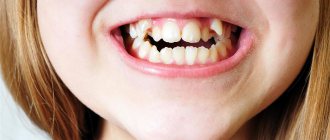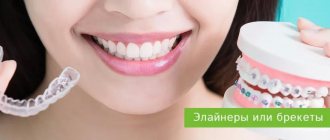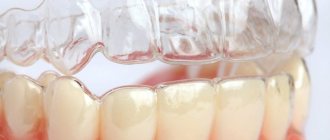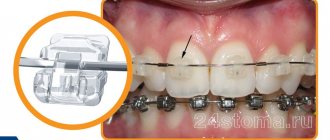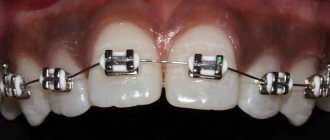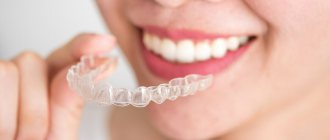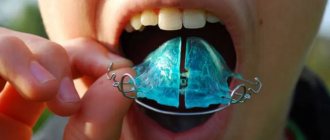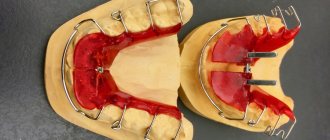HomeOrthodonticsBrackets or aligners
Friends!
My name is Alexander Ovsyanik, I am the author of this article, an orthodontist with 11 years of experience, including 9 of which I have been doing “invisible orthodontics”—straightening teeth without the use of braces.
I have completed all the main European educational courses for orthodontists and have been a platinum partner of the Direct.Dental orthodontic project since 2015.
According to the rating of the independent dental portal 32top.ru, I am among the TOP 3 best orthodontists in Moscow.
I have extensive experience in orthodontic treatment, both using braces and using a more modern teeth straightening technique - aligners.
Visit me on Instagram using the link:
Orthodontist Alexander Ovsyanik. Official page on Instagram.
On this page of our website, I will tell you about the differences between braces and aligners, which will help you decide on a method for correcting your or your child’s bite.
Aligners or mouth guards for straightening teeth are a new technology in orthodontic treatment that was developed in the USA about 15 years ago and has proven itself well in clinical use.
Braces were developed more than 40 years ago; at the moment, they are the most studied and most advanced system for straightening teeth and correcting bites.
How are aligners different from braces?
Aligners are removable and invisible, while braces, even if they are ceramic or sapphire, will always be visible to others. As for lingual systems that are attached to the inner surface of the teeth, the question of the ease of wearing such structures remains open.
The comfort of using aligners as an alternative to braces is beyond doubt. Aligner aligners are made of a special medical-grade plastic/polymer material, which allows them to fit tightly to the teeth and, unlike braces, create the feeling of a smooth surface, which provides the patient with comfort for the entire period of wearing them. In addition to all of the above, the ability to remove aligners when necessary provides a huge advantage in today's competitive and fast-paced world.
Braces
Braces are classic orthodontic systems. These are non-removable devices for correcting bites and other dental defects. The design includes locks that are attached to the teeth, as well as arches of different shapes and diameters that exert a force on the uneven row.
Locks are made from ceramic, metal, plastic and sapphire. The arcs are only metal. At the stage of creating the system, it is given the desired shape. When installing, the arch is pulled so that it puts pressure on the dentition and changes the position of individual units. Over time, the arc returns to its original shape, due to this, correction is performed.
At the PROPRICUS clinic, vestibular and lingual braces are installed. The first are attached to the outer surface of the teeth, the second - to the inner. Vestibular - budgetary systems. Lingual devices are expensive, but invisible in the mouth. Installation of lingual models is more complex.
Metal clasps are durable and inexpensive, but are easily visible on teeth. Plastic systems look attractive and are also inexpensive, but their service life is limited. Structures often break and do not eliminate complex forms of deformation. An alternative to plastic is transparent sapphire models or ceramic products, like veneers. The color of ceramic systems is identical to the shade of enamel. Both designs are invisible in the mouth, but are more expensive.
There are several advantages to braces. Any correction is possible, since systems with a metal arch eliminate all types of deformations and pull impacted teeth out from under the gums. The structures are not removed during nutrition, so the bite correction occurs continuously.
Indications
Braces are effective orthodontic systems that eliminate all malocclusions without surgical intervention. The devices shift teeth, rotate them around their axis, and return canines and incisors that have grown outside the dentition back into place. Treatment is possible regardless of age.
Contraindications
Installation is not recommended if there are implants in the dentition. The artificial root is firmly fixed in the bone, but constant exposure to braces can damage the prosthesis. Correction is undesirable for patients who are unable to provide thorough oral care and have carious teeth, as well as in the presence of soft tissue diseases. Before treatment, it is necessary to undergo sanitation, and for hygiene you need to develop good habits. We are talking about regular cleaning of products, rinsing the mouth, etc.
Installation of braces is not allowed if:
- malignant neoplasms;
- mental disorders;
- alcoholism and drug addiction;
- tuberculosis;
- immunodeficiency;
- complex endocrine disorders;
- blood diseases.
The devices are also undesirable for patients with bruxism and during pregnancy. If the structure was installed before conception, the possibility of continuing treatment is determined by the orthodontist.
Need some advice?
Enter your phone number and we will give you a free consultation
I want a consultation
*By making an appointment you consent to the processing of your data
Visible when smiling or not
An alternative to braces - aligners - are actually practically invisible on your teeth, and none of the people around you will guess that you are undergoing orthodontic treatment. Of course, unless they are practicing orthodontists. Preference is given to aligners, primarily for aesthetic reasons. It is more difficult for patients in adulthood to change their habits. Treatment without braces fits perfectly into their daily lives. In addition, an alternative to braces - aligners - moves teeth very delicately, which is very important not only for adult patients, but also for teenage patients.
EXTREMELY DURABLE ALIGNERS OF THE LATEST GENERATION
At the moment, the treatment I carry out using aligners is based on the use of especially strong, reinforced trays to straighten teeth. This design of the aligner allows you to reduce treatment time and reduce the number of additional corrections due to the fact that the aligner did not work 100% during the main course.
In my practice, I use a unique orthodontic treatment method - VIP protocol for teeth straightening and bite correction using aligners.
What does the VIP protocol mean when using mouth guards to straighten teeth:
- The patient undergoes a computed tomography scan, which shows the location of the roots of the teeth that are to be moved. During a routine examination, the doctor cannot see the roots of the teeth, he only guesses how they are located. A high-resolution computed tomogram creates a 3D model of the patient’s dentition and root system.
- The patient takes impressions of his teeth, which are placed in an extraoral 3D scanner. This system provides significantly greater accuracy than scanning teeth in the oral cavity.
- In a 3D computer modeling program, a computer tomogram of teeth and roots is combined with a 3D scan of the dentition. Our orthodontist, using the latest generation software, simulates the movement of roots and teeth, virtually aligning the teeth and correcting the patient’s bite.
Thus, the VIP protocol is a 3D planning of the alignment of not only the teeth, but also their root system using computed tomography, which allows you to normalize the bite and straighten the teeth in a shorter time, without complications and get a more correct and durable result that will last a lifetime .
Read my large article on teeth straightening and bite correction using aligners. In it you will find a lot of up-to-date information about this technology, the cost of the course, many photographs before and after treatment using aligners for teeth straightening.
Follow the link: ALINERS ACCORDING TO VIP PROTOCOL - THE MOST MODERN WAY OF USING TRAYS FOR TEETH ALIGNMENT.
Look at the review of my patient, actress and TV presenter Yana Troyanova about treatment with aligners.
Features in nutrition
It is known that wearing braces limits a person's consumption of a number of foods. The advantage of treatment with aligners is that patients do not have to give up their favorite meals and snacks for fear of food getting stuck and damaging the orthodontic structure. Unlike braces, you don't have to make sacrifices for aligners and give up nuts, apples, corn, chips, popcorn and other foods. However, be sure to brush your teeth after eating and before putting on your aligners.
Pros and cons of aligners and braces in use
Comparing aligners and braces allows you to understand the question of which technology is best to choose in your case. Each technology has its own advantages and disadvantages, and for convenience we will summarize them in a table.
| Comparison options | Aligners | Braces |
| Appearance | Transparent aligners | Locks. glued to the teeth, and a metal arch connecting them |
| Color | Transparent | Any |
| Material | Polymer | Metal/Polymer/Ceramics |
| Allergenicity | No | Yes |
| Are they suitable for children? | No | Yes |
| 3D modeling of jaws on a computer | Yes | No |
| Discussion with the doctor of the result and patient participation in treatment | Yes | No |
| Preparation time | 7 days | 1-2 days |
| Installation time | 45-60 minutes | 3-6 hours |
| Taking impressions before installation | Oral scan + impressions | Yes |
| Treatment speed | 30% faster | Slower |
| Impact mechanics | Simultaneous rotation and displacement of the tooth in the desired direction due to tight coverage | Consecutive displacement in one direction or another and rotation |
| Risk of caries | No | Yes |
| Possibility of enamel remineralization | Yes | No |
| Possibility of injury to the mucous membrane | No | Yes |
| Frequency of visits to the doctor for correction | Every 4-6 weeks | Every 2 weeks |
| Dietary restrictions during treatment | Almost not | Yes |
| Possibility to remove the structure for eating or cleaning | Yes | No |
| Food getting stuck between teeth | No | Yes |
| Bad breath after eating | No | Yes |
| Difficulty in oral hygiene | No | Yes |
| The need to brush your teeth after every meal | No | Yes |
| The need to use dental floss and toothpicks | If necessary | Necessarily |
| Using a special toothbrush | No | Yes |
| Toothbrush lifespan | Standard | Short (due to increased wear) |
| Opportunity to see results before treatment begins | Yes | No |
| Need to be worn constantly | No | Yes |
| Psychological comfort and self-esteem | Yes | No |
| Aesthetics of appearance | High | Low |
| Feeling of discomfort | No | Yes |
| Possibility of pain at the beginning of treatment | No | Yes |
| Impaired diction | Almost not | Yes |
| Protecting teeth from injury | Yes | No |
| Ease of installation and wearing | Yes | No |
| Possibility of self-replacement | Yes | No |
| Possibility of peeling off | No | Yes |
| Disruption of the usual way of life and forms of communication | No | Yes |
As can be seen from the above comparison, aligners are more convenient in almost everything. Braces cause more discomfort, require changes in the usual lifestyle and diet, and, in fact, the only case when braces are preferable is when the patient is a child. Therefore, when choosing between braces or aligners, according to the orthodontist, it is better to prefer aligners.
In terms of effectiveness, which is better - aligners or braces?
Some orthodontists believe that with the help of aligners, only mild malocclusion pathologies can be corrected, while others, on the contrary, argue that mouth guards can cure everything that can be treated with braces. However, individual aligner manufacturers, including Align Technology, publish examples of successful treatment of malocclusions of various levels of complexity.
Caring for braces and aligners
If you still haven’t decided what to prefer, aligners or braces, and considering their pros and cons, pay attention to the simple rules of care in relation to transparent aligners. Experts recommend removing them from the mouth after each meal, rinsing thoroughly with water and cleaning with a brush. They have a polished surface that is not prone to deposits. In turn, due to the absence of sharp elements, it is possible to prevent the accumulation of food particles. However, there is one undesirable point - the high probability of plastic staining when drinking coffee and tea.
As for traditional braces, they are much more difficult to clean. Particles of solid food may accumulate under the arch and in the area of the locks, which indicates the need to use special brushes, brushes and dental floss. In the absence of proper hygiene, deposits can provoke the appearance of carious lesions.
What is more expensive - aligners or braces?
For example, the cost of treatment using Russian aligners is comparable to treatment with braces. In addition, it is worth considering that you pay once for the entire treatment, until the planned result is achieved. There are no hidden fees during the treatment process with aligners, as is often the case with braces (for example, fees for additional impressions, removal of braces, etc.). A set of aligners is custom-made for each patient, and the results of the correction are displayed and tracked in a personalized virtual treatment plan.
The price of treatment with American aligners will be higher than with premium lingual braces. Mouth guards from European manufacturers will cost a little less. The cost of Russian-made aligners starts from 80,000 rubles, which is commensurate with the cost of inexpensive metal braces. It should be clarified whether the indicated price includes diagnostics and a treatment plan. Clinics often announce the lowest cost limit, which is applicable only in simple cases that are very rare. In the case of aligners, you should also inquire about the possibility of replacement if they are damaged or lost. Often, the extremely low cost of aligners in some clinics entails additional costs, which the patient is informed about during the treatment process.
What to choose
What is better, braces or aligners, is not determined by the cost item. The cost of mouth guard correction is offset by many benefits. In addition to the speed of correction, the patient receives aesthetics and wearing comfort, which is due to the design of the plates. The person will not experience embarrassment, as often happens with braces. There is no need to be ashamed of your smile and laughter, or purse your lips during a conversation.
There are no dietary restrictions when wearing mouth guards. You can eat solid foods after removing the product from your mouth. It is impossible to remove the braces temporarily, so you will have to give up some food, otherwise the structure may be damaged. After eating, you need to rinse your mouth thoroughly and brush your teeth, as food debris gets stuck in the locks. Difficulty with oral hygiene leads to the formation of caries and additional treatment, whereas such problems do not arise with aligners. Eating and brushing your teeth are no different.
If you have any doubts about the treatment method, sign up for a consultation at PROPRICUS dentistry. The doctor will conduct a diagnosis, assess the condition of the oral cavity and recommend an orthodontic design model that will eliminate the identified defects. We provide comprehensive services, including examination, choice of treatment method, preparation of the impression, attachment of the device, as well as regular monitoring. We eliminate even complex deformities using aligners and provide painless treatment. Clients of the clinic can expect a cozy atmosphere, fast and professional service.
Additional doctor visits and procedures
| Additional doctor visits and procedures | ALINERS | BRACKETS | VENEERS |
| Frequency of doctor visits | Once every 4-6 weeks | every 2 weeks | after fixation once 6 months |
| Probability of root canal treatment | low | low | high |
You should most rarely visit a doctor after installing veneers, most often - every two weeks - when installing braces. Aligners are a relatively comfortable visit once every month to a month and a half.
Seriously speaking, it is best to be treated with aligners
Why?
Yes, because they have a huge number of advantages over braces. There are only a few difficult dental pathologies that aligners cannot handle. But all other problems of crooked teeth are perfectly corrected by aligners! Star Smile is represented by orthodontists in more than 70 (!) cities of Russia. And we guarantee you the most comfortable prices for treatment with aligners! To make sure of this, leave a request for a FREE consultation with an orthodontist in your city. Do you want to visit an orthodontist completely free?
Stages of treatment
The aligners are made of soft silicone, they are very thin and fit tightly to the teeth. Aligners are developed strictly individually and only in the companies that develop these products. That is, preparation, approval of the plan, taking impressions and monitoring of the treatment are carried out directly in the clinic.
The patient is given a full set of aligners for the entire period of treatment (and its duration is usually about 9-12 months, less wearing braces). (the amount varies depending on the severity of the malocclusion). Each aligner has its own shape and has a specific effect on the teeth, causing them to move in the desired direction. If you use the system correctly, the first results will be noticeable within 3-4 months.
According to numerous studies, mouth guards have virtually no restrictions on their use. And with a competent approach, they allow you to solve problems of malocclusion of any complexity1.
How to wear aligners
Each mouthguard must be worn for about 2 weeks, strictly observing the date of replacement. The daily norm of wearing a mouthguard is at least 20 hours; the aligner must be removed while eating or performing hygiene procedures.
After removal, the aligner must be cleaned; after eating, be sure to brush your teeth and remove any remaining food from the interdental spaces. It is important to store the aligner in a special container that will protect the aligner from dust and external influences.
The most popular brands
In Russia and the CIS countries, mouth guards from the following manufacturers are most widespread:
- Ortosnap. Made in the USA. They have proven themselves to be the most durable and most affordable. Can be used in adolescents from 12 years of age.
- Invisalign. They have a special fastening system, thanks to which they can cope with a fairly wide range of orthodontic problems. According to a number of experts, they allow bite correction to be carried out in a short time.
- Clerar Correct. The manufacturer relies on the environmental friendliness of its products. Hypoallergenic mouth guards do not accumulate pigments from food and drinks, do not darken, do not cause allergic reactions and do not irritate the mucous membranes.
- Invisible All In. They are distinguished by the most uniform distribution of the load on the teeth, which makes Italian-made products one of the best substitutes for braces.
- Denti Belli. These Italian mouth guards are made using a 3D printer, which allows for exceptional accuracy of each pair of mouth guards developed by a computer model.
